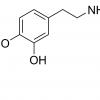We are already a group of 9 people, who all want to buy 6-Hydroxynorketamine. It is not yet available "off the shelf", but we found a chemical company, which could synthesize it for us.
We have an offer for 10 grams, but need at least 2 more buyers to meet the price.
If you are interested, drop an e-mail at hnk6 (at) tutanota (dot) com with:
1. Your full name (ours will also be disclosed to you)
2. Your country
3. Your disease (depression?)
4. Optional: your profession
Why do we want to try 6-HNK?
1. Ketamine has been reported to quickly relieve depression in appr 75% or TRD (treatment resistant depression) either at a dosage of 0.5 mg / kg i. v. or sublingual (30% bioavailibility). Literature: There is a great book on Amazon "Ketamine for depression".
2. It has been shown that Ketamine is especially effective in "anxious depression" rather than in the depression without anxiety. This was to the astonishment of the researchers as anxious depression has been shown to react worse to regular SSRI/SNRI and to CBT (cognitive behavioral therapy) than depression without anxiety. However, for all anxious depressed, this is good news. Lit: Ionescu et al., "Effect of baseline anxious depression on initial and sustained antidepressant response to ketamine".
3. Recently, the same group from the NIH (!) published an important study in Nature (!!!). In rats, they showed that neither does ketamine lift depression via the NMDA-receptor nor does it lift depression at all. Rather, it is its metabolite (2R, 6R)-hydroxynorketamine, which lifts the depression! Good news: it does that via the AMPA-receptor and does NOT induce dissociation or addiction (at least as the rats are concerned).
Interestingly, there are more data that support that ketamine/NMDAR fails to work against depression: a) esketamine works less than the R-ketamine (because the metabolite 2S,6S-hydroxynoketamine is not as potent as 2R,6R), b) a couple of studies of NMDAR-antagonists have already failed from some pharma companies.
4. Approximately 15% of Ketamine is metabolized into (2R,6R)-Hydroxynorketamine (more in female rats than in males). The oral bioavailibility of HNK is supposedly 50% according to the literature. Thus, I calculate: 0.5 mg/kg of ketamine i.v. equals approximately 80 kg * 0.5 mg/kg = 40 mg of ketamine or 15% of that: 6 mg of HNK. Given orally, 12 mg should be used and if the product contains (2S, 6S) and (2R, 6R), then appr. 24 mg should be taken orally (I guess).
Of course, this could be all bogus, but I have the feeling that this may actually work. After many different antidepressants, the only drug to temporarily lift my anxious depression is lorazepam (a benzo), which of course leads to addiction and doesnt work in the long run anyway, but it also works on that GABA/AMPA-receptors.
HNK6
























































